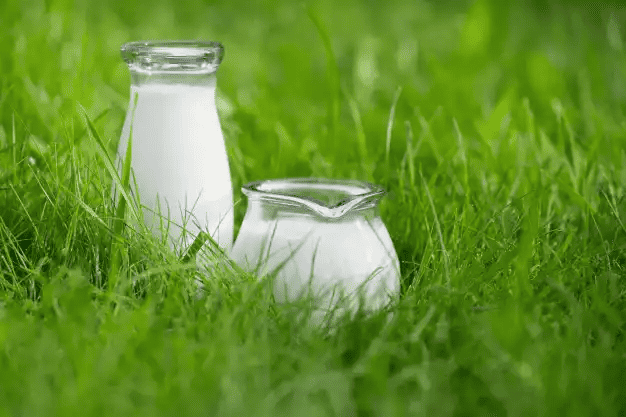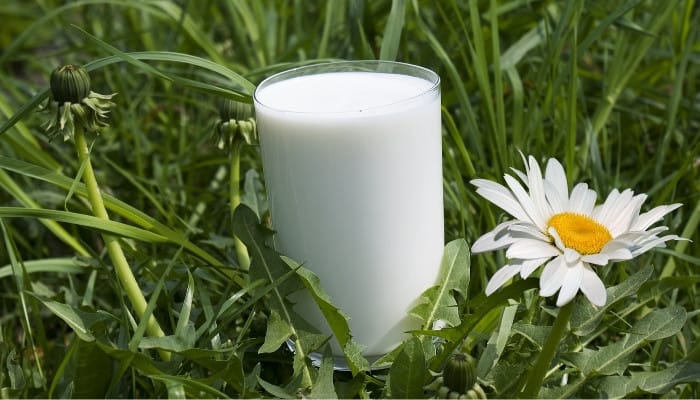In addition to being a staple in human diets, milk is also a valuable source of calcium, vitamin B, sugar, and protein for plants in the garden. This natural ingredient not only benefits our own health but also promotes plant growth. Properly utilized, milk can serve as a natural fertilizer and aid in the care of plants.
Is milk good for plants? Yes, it contains calcium, vitamin B, and proteins that promote plant growth and health. You can use milk as fertilizer or for cleaning plant leaves, but remember to use it sparingly to avoid harmful effects.
While milk can add some benefits in the form of calcium and trace amounts of nitrogen, overuse or incorrect application could lead to issues. It’s crucial to know how to use milk effectively on plants, for watering, fertilizing, or leaf cleaning. Explore methods to integrate milk in your garden for the best plant health and growth..
Key Takeaways:
- Nutritional Benefits for Plants: Milk is an excellent source of calcium, vitamins, and proteins, offering vital nutrients that promote plant growth and health.
- Best Type of Milk to Use: Fresh, low-fat (2%) or sour milk is the most beneficial for plants. Avoid using flavored, sweetened, or full-fat milk as they can cause more harm than good.
- Advantages of Watering with Milk: When used correctly, milk enhances soil health, aids in pest control, and acts as a natural fertilizer, providing a multifaceted approach to plant care.

How To Use Milk For Your Plants – Step By Step Guide
While milk can be beneficial, overuse could lead to issues like black rot and soft rot. It is important to approach using milk for plants with caution. Here’s a simple guide to using milk effectively for your plants:
- Prepare the Milk Solution: Mix equal parts milk and water (50:50 ratio); Pour into the spray bottle, and shake well; Apply generously to the plant foliage; Wait for an hour; Remove the excess mixture with a moist cloth.
- Select the Right Milk: Fresh milk is ideal, but spoiled milk can also be used. Both are rich in nutrients beneficial for plant growth.
- Watering with Milk: Use the milk mixture to water the plants at the base. Avoid getting milk on the leaves to prevent fungal diseases.
- Special Care for Houseplants: For houseplant care, use the milk mixture sparingly. Focus on the soil rather than the leaves.
- Leaf Nourishment: If you’re wondering how to clean plant leaves with milk, simply dampen a soft cloth with the diluted milk and gently wipe the leaves. This not only cleans them but also provides a subtle nourishment boost. Applying the milk mixture to the leaves is called foliar feeding (this article covers foliar feeding and different foliar sprays extensively).
- Consistent Application: Apply the milk mixture to your plants once every two weeks. This frequency ensures that your plants receive enough nutrients without the risk of overuse.
- Observe Plant Response: After applying milk, watch for signs of improved health like better leaf color and vigor. If you notice any negative effects, reduce the frequency or concentration of milk.
- Consider Plant Type: While most plants will benefit from milk, some, like acid-loving plants, may not respond as well. It’s also worth noting that milk can be beneficial for trees, but the application should be less frequent due to their size.
Benefits of Using Milk for Plants
Milk brings several top benefits to plant care, enhancing growth and protecting against pests and diseases:
- Calcium Source: Milk, rich in calcium, is essential in combating blossom end rot in various plants, promoting healthy development.
- Fertilizer: does milk help plants grow faster than water? Yes, In fact, as a natural fertilizer, milk provides vitamin B and protein nutrients to support robust plant health.
- Pest Control: Milk is effective against common pests like aphids, making it a valuable addition to plant care routines, especially for houseplants and gardens.
- Antifungal Agent: Is milk good for plant leaves? Yes – Spraying milk on plant leaves helps prevent fungal diseases due to its antiseptic properties under sunlight.
- Soil Health Enhancer: Incorporating milk into soil fosters beneficial microbial growth.
- Disease and Pest Prevention: Regular use deters soil pathogens and insects.
Milk’s multifaceted benefits make it a versatile and effective tool in natural plant care, ranking it among the most beneficial organic treatments available (Source)
What Types of Milk To Use for Plant Care?
In the old days, milk was milk. It came from a cow and was enjoyed as a drink or made into butter, cheese, or cream. As time went on, milk was pasteurized, and made into ice cream, dessert treats, and milkshakes. Nowadays, milk can come from cows, goats, sheep, camels (yes, it’s true), and even plants. And it doesn’t end there.
Milk can be skimmed, low-fat, full-fat, powdered, evaporated, fresh or sour. Milk selection is now a minefield, and so the question is, which milk is beneficial for plants?
The Most Popular Choice – Milk That is Good for Plants:
- Fresh cow’s milk (2% low fat).
- Sour milk.
- Evaporated.
- Powdered milk.
- Buttermilk.
- Evaporated milk.
- Almond.
- Soy.
Don’ts – Milk That You Should Not Use:
- Flavored milk.
- Sweetened condensed milk.
- Skim milk.
- Full fat (undiluted).
Not all milk is made equal, and therefore they are not all beneficial to plants. Some types of flavored milk and sweetened condensed milk are high in sugar and are highly processed too. These will have little nutritious value for plants and may attract unwanted pests and problems.
While skim milk can promote the development of black rot and soft rot, the fat in full-fat undiluted milk can damage the plant’s foliage – so it’s really all about balance.
Watering Plants With Milk
Watering plants with milk, aside from providing nutrients like calcium and proteins, can also improve soil health. The beneficial bacteria in milk can help break down organic matter, enhancing soil structure and promoting healthier root growth. This improved soil environment can be particularly advantageous for plants that thrive in well-aerated and nutrient-rich soil. However, it’s crucial to use milk in moderation to prevent negative effects like rot and fungal growth. (Source)

These plants, among others, might benefit more from the soil-enhancing properties of watering with milk:
- Jade Plants: These plants could benefit from the improved soil structure and nutrient availability.
- Begonias: Enhanced soil health might aid in their growth and flowering.
- English Ivy: Beneficial bacteria in the soil could support their root systems and overall health.
- African Violets: Improved soil conditions could lead to healthier growth and blooming.
Milk as Fertilizer
To utilize milk effectively as a fertilizer, it’s recommended to dilute it with water in a ratio of 1 part milk to 9 parts water. This mixture should then be applied to the soil around the plants. This method helps avoid potential issues like odor and mold growth on the foliage. The primary advantages of using milk as a fertilizer include providing essential calcium for plant growth, activating beneficial soil microbes, and offering nutrients like potassium and phosphorus. Additionally, it aids in enhancing plant immunity against various stressors.
These plants typically thrive with the nutrient boost provided by diluted milk used as a fertilizer:
- Leafy vegetables like spinach and kale
- Flowering plants such as roses and tomatoes
- Fruit-bearing plants
How to Clean Plant Leaves With Milk

Cleaning the leaves of your plant with milk is much like foliar feeding. After spraying the leaves with a diluted mixture of milk and water, allow the leaves to absorb the milk for approximately 30 minutes.
Then wipe off the excess milk with a soft, damp cloth. Cleaning the leaves with milk will also protect the leaves from unwanted pests looking for a tasty snack!
Pests such as aphids, thrips, and mealybugs cannot process milk enzymes, which leads to their demise!
Frequently Asked Questions (FAQ):
How Often To Use Milk for Plants?
When used as a fertilizer, milk is only required once at the beginning of the growing season and again mid-season when plants are actively growing.
If using milk as a pesticide or fungal treatment, apply a milk solution to the leaves as soon as signs of disease or pest are seen.
Can Milk Use Harm Plants?
Overwatering plants with milk can cause poor plant health. In addition to an unpleasant odor caused by the excess rotting milk, plants may experience poor growth and appear wilted. Also, excess milk can also cause black rot and Alternaria leaf spot.
Does Milk Help Plants Grow Faster Than Water?
When provided with the correct level of care, water, heat, and light, plants will naturally grow at their fastest. However, milk can promote healthy, vigorous growth due to its nutritional value.
Is Spoiled Milk Good for Plants?
Milk, even if it is past its expiration date, is good for plants in moderation. Apply diluted milk soaking in early spring and again halfway through the summer.
Is Milk Good for Azaleas?

Sour milk has a higher acidity level than fresh milk, making it the perfect drink for azaleas. This is because they thrive in acidic soil conditions.
Is Milk Good for Roses?
A common fungal disease that affects roses is called blackspot or Diplocarpon rosae. Mix a diluted milk solution of equal parts water and milk and use it to spray onto the leaves.
The lactoferrin in the milk is a highly effective fungicide against this type of leaf disease.
Can I Pour Milk on My Tomato Plants?
Milk is excellent for tomato plants. It can be used as a fertilizer and a fungicide for these prolific growers. Tomatoes need a lot of nutrients to ensure healthy plant growth, and milk can provide an abundance of these.
Sprinkle half a cup of powdered milk directly onto the soil and water thoroughly. Repeat every other week during spring and summer. To prevent fungal disease, mix a solution of milk and water (9 parts water to 1 part milk) and spray the foliage every three weeks in the summer.
How To Use Milk and Molasses for Plants
Milk and molasses mixtures are hugely beneficial to plants and the soil. Molasses is a by-product created when sugar beets or sugar canes are processed into sugar.
It contains calcium, potassium, magnesium, and iron, which are excellent for improving the soil.
Use a simple solution of equal parts milk and water mixed with three tablespoons of molasses. Use this to feed plants such as peppers, tomatoes, and eggplants. This will increase their yield and flavor.

